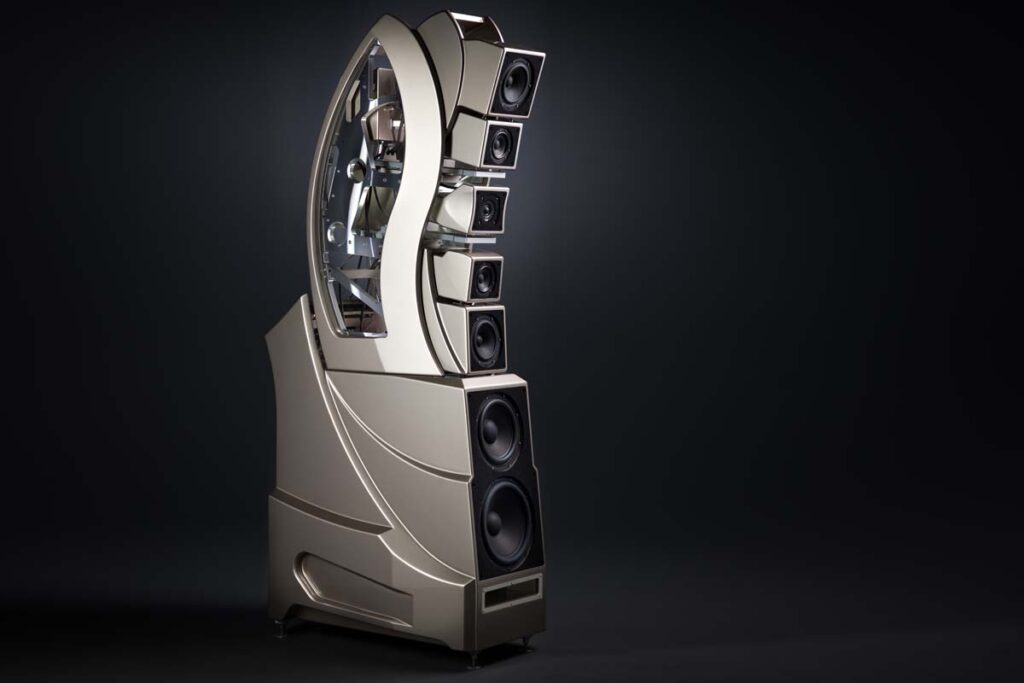Multi-way loudspeakers are so common that we rarely question the need to split the frequency range. Why not just reproduce the entire bandwidth with a single driver? Is more complexity always better?
Let’s approach the of whether we need multiple signal paths by looking at the frequency extremes. The question of why a 25-millimeter driver can’t reproduce bass is fairly easy to answer: it can – just very quietly. This must be true, otherwise headphones wouldn’t work. Since the diaphragm oscillates 1,000 times more often at 20 kilohertz than at 20 hertz, it also transfers 1,000 times as much energy to the surrounding air in the same amount of time – assuming equal diaphragm surface area and excursion – thus producing 1,000 times the sound pressure. Conversely, at 20 hertz, a driver must move 1,000 times more air per cycle to achieve the same sound pressure level. That requires a combination of diaphragm area and excursion.
It’s harder to explain why large drivers make poor tweeters. Intuitively, one might blame inertia, but that’s only partly correct: since a large diaphragm requires only microscopic excursions at high frequencies, you could theoretically attach a motor capable of controlling its start-stop behavior even at very high frequencies. The problem lies more in the diaphragm itself. Up to a certain frequency, its movement remains pistonic; above that point, it breaks up into partial vibrations – essentially, it starts “fluttering,” which produces unpleasant ringing. A large driver that doesn’t break up at high frequencies is much harder to build than a small one.

However, the main reason tweeters are almost always small is their dispersion characteristics. As long as the wavelength a driver produces is larger than the driver’s diameter, the speaker will display a wide radiating pattern. But once the wavelength becomes shorter than the diaphragm’s diameter, the dispersion narrows as the frequency rises. Basic math tells us that a 17-centimeter cone becomes increasingly directional above about 2 kilohertz, whereas a 25-millimeter dome doesn’t beam significantly until around 14 kilohertz. That’s why two-way speakers using this combination – with a crossover somewhere around 2,000 hertz – are so common.
Even if one were willing to accept the narrowing dispersion, a third phenomenon argues against full-range drivers: Doppler distortion. Loudspeakers create sound pressure by moving their diaphragms, and as we now know, lower tones require more excursion to reach the same loudness. So if a full-range driver is asked to reproduce a 1,000-hertz tone and a 50-hertz tone at the same time, the latter needs twenty times the excursion of the former. This means that the “starting point” of the 1-kilohertz wave is being moved back and forth – toward and away from the listener – 50 times per second by an amount equal to twenty times its own excursion. As a result, the wave is compressed and stretched, modulating its pitch – essentially the wicked stepmother of vibrato.
Better as a Team?
With all these drawbacks in mind, a voice in the back of our head might call for a 99-way loudspeaker – but if you look at the market, even high-end speakers often use only two ways, and some are indeed single-driver full-range designs. So cost and complexity can’t be the only factors.

The most obvious argument against multiple ways is the physical distance between drivers, which causes different frequency ranges to reach the listener at slightly different times. This can result in phase-related cancellation effects and generally harm imaging. Smart enclosure design can mitigate this, but typically only at one listening position. The more ways a speaker has, the more it tends to depend on the “sweet spot.”
On top of that, multi-way speakers require a crossover. This means components in the signal path – more ways mean more components – which inevitably introduce some degree of signal degradation. But the far bigger issue is the phase shift introduced by the filters. The steeper the filter slope, the greater the phase rotation (read more on the topic in this article). Since this rotation relates to a wave cycle, the resulting time delay is frequency-dependent: a 180° phase shift equals a 1-millisecond delay at 2 kilohertz, but 10 milliseconds at 200 hertz. How sensitive the human ear is to these timing differences is one of the many hotly debated topics in hi-fi, but if clearly measurable speaker misbehavior can be avoided, one generally should – at least as long as the fix doesn’t introduce even bigger compromises elsewhere.
One thing always holds true: a loudspeaker is a box full of trade-offs.

